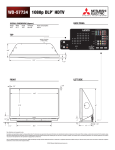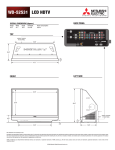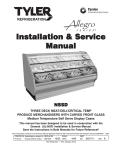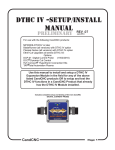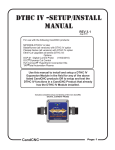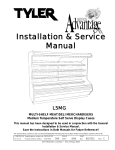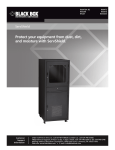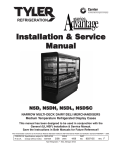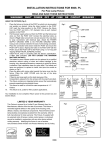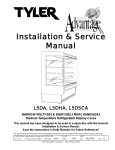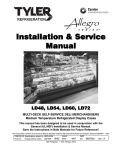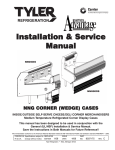Download Installation & Service Manual
Transcript
Installation & Service Manual LDSSI SELF-SERVICE DELI ISLAND MERCHANDISER Medium Temperature Self Serve Display Cases This manual has been designed to be used in conjunction with the General (UL/NSF) Installation & Service Manual. Save the Instructions in Both Manuals for Future Reference!! This merchandiser conforms to the American National Standard Institute & NSF International Health and Sanitation standard ANSI/NSF 7 - 1999. PRINTED IN Specifications subject to REPLACES IN U.S.A. change without notice. EDITION ISSUE DATE 5/04 Tyler Refrigeration * Niles, Michigan 49120 PART NO. 9805002 REV. LDSSI Tyler Refrigeration CONTENTS Page Specifications LDSSI Specification Sheets . . . . . . . . . . . . . . . . . . . . . . . . . . . . . . 4 Line Sizing Requirements . . . . . . (See General-UL/NSF I&S Manual) Pre-Installation Responsibilities . . . . . (See General-UL/NSF I&S Manual) Installation Procedures Carpentry Procedures . . . . . . . . . . . . . . . . . . . . . . . . . . . . . . . . . 5 Plumbing Procedures . . . . . . . . (See General-UL/NSF I&S Manual) Refrigeration Procedures . . . . . (See General-UL/NSF I&S Manual) Electrical Procedures . . . . . . . . . . . . . . . . . . . . . . . . . . . . . . . . . . 5 Electrical Considerations . . . . . . . . . . . . . . . . . . . . . . . . . . . . . . . . 5 Defrost Information . . . . . . . . . . . . . . . . . . . . . . . . . . . . . . . . . . . . 5 Defrost Control Chart . . . . . . . . . . . . . . . . . . . . . . . . . . . . . . . . . . . 5 Installation Procedure Check Lists (See General-UL/NSF I&S Man.) Wiring Diagrams . . . . . . . . . . . . . . . . . . . . . . . . . . . . . . . . . . . . . . . . . . . 6 LDSSI Domestic & Export (50Hz) Case Circuits . . . . . . . . . . . . . . . 6 Cleaning and Sanitation . . . . . . . . . . . (See General-UL/NSF I&S Manual) Component Removal and Installation Instructions for Cleaning 7 Screens . . . . . . . . . . . . . . . . . . . . . . . . . . . . . . . . . . . . . . . . . . . . . 7 Bottom Trays . . . . . . . . . . . . . . . . . . . . . . . . . . . . . . . . . . . . . . . . . 7 Discharge Air Honeycomb . . . . . . . . . . . . . . . . . . . . . . . . . . . . . . . 7 Rear Air Duct Panels . . . . . . . . . . . . . . . . . . . . . . . . . . . . . . . . . . 7 Front Air Ducts Panels . . . . . . . . . . . . . . . . . . . . . . . . . . . . . . . . . 7 Base Access Panel . . . . . . . . . . . . . . . . . . . . . . . . . . . . . . . . . . . . 7 Plexiglas Care . . . . . . . . . . . . . . . . . . . . . . . . . . . . . . . . . . . . . . . 7 Cleaning . . . . . . . . . . . . . . . . . . . . . . . . . . . . . . . . . . . . . . . . . . . . 7 Waxing . . . . . . . . . . . . . . . . . . . . . . . . . . . . . . . . . . . . . . . . . . . . . 7 Page 2 May, 2004 Installation & Service Manual LDSSI Page General Information NSF Product Thermometer Installation . . . . . . . . . . . . . . . . . . . . 8 Radiant Heat Information . . . . . . . . . . . . . . . . . . . . . . . . . . . . . . . 8 Radiant Heat Measurement . . . . . . . . . . . . . . . . . . . . . . . . . . . . . . 8 Display Practices . . . . . . . . . . . . . . . . . . . . . . . . . . . . . . . . . . . . . . 8 Service Instructions Preventive Maintenance . . . . . . (See General-UL.NSF I&S Manual) Fan Blade and Motor Replacement (See General-UL/NSF I&S Man.) NSF Product Thermometer Replacement . . . . . . . . . . . . . . . . . . 9 Perimeter Plexiglas Replacement . . . . . . . . . . . . . . . . . . . . . . . . 9 Bumper Replacement . . . . . . . . . . . . . . . . . . . . . . . . . . . . . . . . . 10 Lower Access Panel Removal . . . . . . . . . . . . . . . . . . . . . . . . . . 10 Parts Information Operational Parts List . . . . . . . . . . . . . . . . . . . . . . . . . . . . . . . . . 11 TYLER Warranty . . . . . . . . . . . . . . . . . (See General-UL/NSF I&S Manual) The following Medium Temperature Self-Service Deli Island Merchandiser models are covered in this manual: MODEL DESCRIPTION LDSSI 8’ SELF-SERVICE DELI ISLAND MERCHANDISER LDSSI 12’ SELF-SERVICE DELI ISLAND MERCHANDISER May, 2004 Page 3 LDSSI Tyler Refrigeration SPECIFICATIONS LDSSI Self-Service Medium Temperature Deli Island Merchandisers Page 4 May, 2004 Installation & Service Manual LDSSI INSTALLATION PROCEDURES Carpentry Procedures Defrost Information The LDSSI models do not require any specific carpentry procedures. The cases are shipped as complete islands. Make sure the floor is level where the cases are to be installed. Electrical, refrigeration and drain access should be located under the cases. See “General-UL/NSF I&S Manual” for operational descriptions for each type of defrost control. Defrost Control Chart After island case is installed, install the bottom trays, the case screens and the base access panel. Defrost Defrost Defrosts Duration Per Day (Min) Type Off Time 4 40 Refrigeration Procedures WIRING DIAGRAMS See “General-UL.NSF I&S Manual” for general system, control and superheat information. Electrical Procedures Electrical Considerations CAUTION Make sure all electrical connections are tight. This prevents burning of electrical terminals and/or premature component failure. Term. Temp. ----- ELECTRICIAN NOTE - OVERCURRENT PROTECTION 120V circuits should be protected by 15 or 20 Amp devices per the requirements noted on the cabinet nameplate or the National Electrical Code, Canadian Electrical Code - Part 1, Section 28. 208V defrost circuits employ No. 12 AWG field wire leads for field connections. On remote cases intended for end to end line-ups, bonding for ground may rely upon the pull-up bolts. The following wiring diagram on page 6 covers all the LDSSI case circuits. NOTE The electrical box, behind the base access panel, houses the electrical terminal block and wiring for the case. The electrical box covers will be shipped loose. Case Fan Circuit This circuit is to be supplied by an uninterrupted, protected 120V circuit. The case fan circuit is not cycled. May, 2004 Page 5 LDSSI Domestic & Export (50Hz) Case Circuits (8’ & 12’ Island Cases) Page 6 May, 2004 Installation & Service Manual LDSSI CLEANING AND SANITATION Front Air Duct Panels Component Removal and Installation Instructions for Cleaning 1. Remove screens and bottom trays, see this page. Screens 3. After cleaning, replace in reverse order. 1. Remove product from screens. Base Access Panel 2. Push screens back until front screen tabs clear the holes in the front duct. 3. Remove screens from holes in rear duct panels and from case. 4. After cleaning, replace in reverse order. Bottom Trays 1. Remove product and screens from case. See this page. 2. Grasp and lift out each of the bottom trays from the case interior. 3. After cleaning, replace in reverse order. 2. Remove screws and front air duct panels from case. NOTE Note position of the base access panel during removal so it can be reinstalled the same way. 1. Remove screws and base access panel from lower front section of the case. 2. After cleaning base access panel and under the case, replace the base access panel and secure with screws. Plexiglas Care Cleaning Discharge Air Honeycomb 1. Remove screws and bottom retainer strip from rear interior of case. NOTE Note position of the honeycomb grid during removal so it can be reinstalled the same way. 2. Remove honeycomb grid sections from the rear duct. CAUTION Improper installation of the honeycomb grid section could result in improper air flow and/or poor refrigeration. 3. After cleaning, replace honeycomb grid sections as they were removed and secure with the bottom retainer strip and screws. Rear Air Duct Panels 1. Remove screens, bottom trays and discharge air honeycomb, see this page. CAUTION DO NOT use paper towels, soft cloths, sponges or chamois to clean plexiglas. These materials will scratch the acrylic surface. Clean with lukewarm water and plenty of nonabrasive soap, or detergent. Use only bare hand to dislodge any caked-on dirt. Lightly dry with a clean damp chamois or clean soft cloth. Waxing Wax should be applied in a thin even coat, and brought to a high polish by rubbing lightly with a dry clean soft cloth. Excessive rubbing may cause scratching and/or buildup an electrostatic charge, which attracts dust and dirt to the surface. Electrostatic charge can be removed by blotting acrylic surface with a clean damp cloth. 2. Remove mounting screws from rear duct panel. 3. After cleaning, replace in reverse order. May, 2004 Page 7 LDSSI Tyler Refrigeration GENERAL INFORMATION NSF Product Thermometer Installation Product Thermometer Install and secure a new product thermometer with two screws below the return air duct on the left end of the case. Radiant Heat Information the cases. A dial thermometer stuck into the center of a piece of meat compared with one in the air stream quickly confirms this fact. Another fact is that the surface temperature of the meat will be higher than the center temperature due to radiant heat. TYLER’s ongoing research identifies sources of radiant heat and accurately measures and records it. These charts were developed from the information gathered during this research. Two major sources of radiant heat are from display lights and ceiling surfaces. Additional heat sources come from bad display practices which either overload the case with product or allow voids in the product display. Poor display practices impair the efficiency of the refrigeration, adding to the surface temperature of the meat. Bacteria and molds grow when surface temperatures rise above 45°F. This prematurely discolors displayed meats and causes unnecessary meat department losses. Radiant Heat Measurement Place two accurate dial thermometers side by side in a case. Cover one of the thermometer stems with black friction tape. The temperature difference is the approximate amount of radiant heat. A change in display lighting or a reduction of high ceiling temperatures (over 80°F) could reduce the radiant heat in the case. Display Practices Encourage butchers to maintain all meat below the case load lines and to eliminate product voids. Case screens could be covered in some instances to keep the refrigerated air over the display. A wide temperature range is shown for each type of lighting. This data does not show all situations. Many situations will have higher package warm-up figures than indicated. It is generally known that the temperature of displayed meat in refrigerated cases will run higher than the circulated air temperature of Page 8 CAUTION The quality damage done to meat products by high temperatures and/or contamination during delivery, cooler storage, cutting and wrapping cannot be repaired by placing the products into properly operating display cases. May, 2004 Installation & Service Manual SERVICE INSTRUCTIONS See “General-UL/NSF I&S Manual” for fan blade and motor replacement. NSF Product Thermometer Replacement Product Thermometer LDSSI 5. Position and align new section of plexiglas in the opening and set bottom of plexglas in lower track. CAUTION Avoid cement touching clear plexiglas surfaces. If contact occurs, the surface will scar and the final appearance may be unsatisfactory. 6. Using a downing fixture, align the top edge of plexiglas joint seam. Carefully apply acrylic adhesive (Weldon #1802) to joint seam from the outside surface of the plexiglas. Let adhesive dry for 5 minutes. 7. Using the same downing fixture, drill a 1/4” hole through the top of the plexigals joint seam. Remove the downing fixture. 1. Remove two screws and the product thermometer from location below the left front return air duct on the case. 2. Install and secure the new product thermometer with two screws on the case in the same location as it was previously installed. 8. Apply acrylic adhesive to 1/4” acrylic dowel pin and insert the pin in top hole. Let acrylic adhesive dry for 5 minutes, then cut off excess dowel pin and file smooth. Plexiglas Finishing Procedure Perimeter Plexiglas Replacement 1. If joint seam of plexiglas does not match perfectly, grind uneven seam with #36 grit disc until seam is even. The finish area should be approximately 4 inches wide. Perimeter plexiglas comes in four sections. Each section runs the top perimeter of 1/4 of the case. After installation, the four sections are adhered together into one piece. 3. Repeat step 2 using #280 grit sand paper. 1. Carefully cut apart sections of plexiglas at the joints. Remove broken or damaged plexiglas. CAUTION Make sure ends of adjoining plexiglas are clean and dry. 2. Dry sand using #80 grit sand paper. Increase width of finish area approximately 1/4” on each side. 4. Repeat step 2 using #400 grit sand paper. 5. Wet sand finish area using #800 grit sand paper. 6. Repeat step 5 using #1000 grit sand paper. 7. Repeat step 5 using #1500 grit sand paper. 3. Using a sanding block, sand all adjoining edges of plexiglas to ensure, smooth even edges. 8. Using a buffer, apply Novus brand heavy scratch remover #3 until smooth. 4. Measure and cut replacement section of the plexiglass, if necessary, to approximately 1/4” longer then opening. Block sand edges to make sure they are even and smooth. 9. Repeat step 8 using Novus brand fine scratch remover #2. May, 2004 10. Polish the finish area using a clean soft cloth and Novus brand Plastic Clean and Shine #1. Page 9 LDSSI Bumper Replacement Tyler Refrigeration NOTE The center of the second piece of bumper may need to be snapped into place with a wooden block and a hammer. 6. Starting at both ends and working towards the center, snap the second piece of bumper (3) onto the bumper retainer (2). 1. Find the bumper joint and pry one end of the bumper (1) until it start to release from the bumper retainer (2). 2. Grasp the loose end of the bumper (1) and pull firmly to peel bumper (1) off the bumper retainer (2). 3. Use old bumper as a guide to cut new bumper to the proper length. 4. Starting at one end, snap the new bumper (1) onto the bumper retainer (2). 5. If more than one piece of bumper needs to be used to completely go around the case, measure and cut the second piece of bumper (3) 1/4” longer than the remaining space between the bumper ends. Page 10 NOTE Bumpers will shrink when the cases are at operating temperature. Lower Access Panel There are two lower access panels on this case; one on the front base and one on the rear base. Both of these panel provide access to the drain and/or refrigeration lines to this caes. They also provide access for cleaning under the case. 1. To remove a lower access panel, remove six screws and lower access panel (1) from the base (2) of the case. 2. After completing case maintenance and/or cleaning under the case, replace the lower access panel (1) and secure to base (2) with screws. May, 2004 Installation & Service Manual LDSSI PARTS INFORMATION Operational Parts List Case Usage Domestic Electrical Circuit 115 Volt 60 Hertz Case Size 8’ 12’ Fan Motor 5125532 5 Watt 5125532 5 Watt Fan Motor Brackets 5962269 5962269 Fan Bracket Plate 9041077 9041077 Fan Blades (7.00” 15° 5B) 5223891 5223891 Opt. ECM Fan Motor 9025002 8 Watt 9025002 8 Watt Opt. ECM Fan Motor Brackets 5205005 5205005 Opt. ECM Fan Blades (7.00” 20° 5B) 5960943 5960943 NSF Product Thermometer 5967100 5967100 For information on operational parts not listed above contact the TYLER Service Parts Department. May, 2004 Page 11












